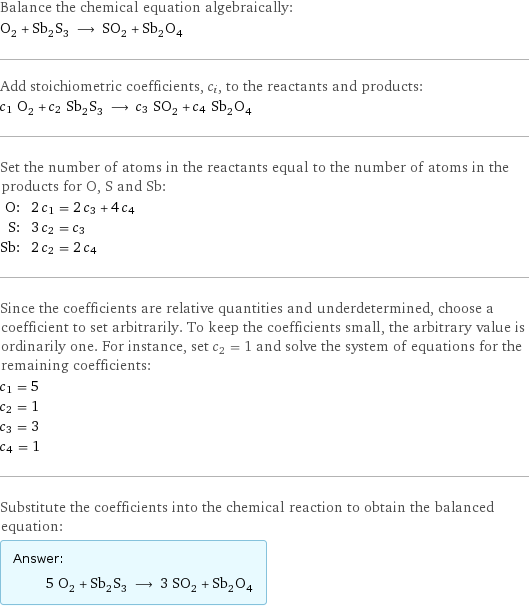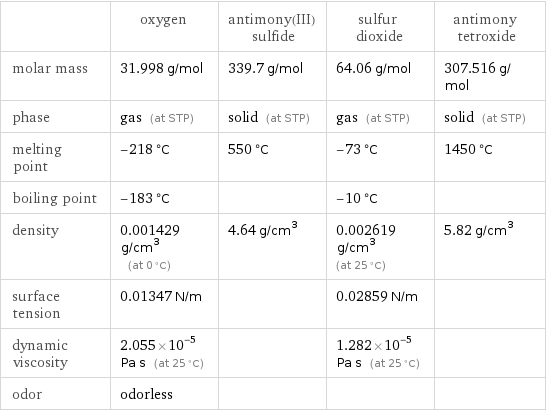Input interpretation

O_2 oxygen + Sb_2S_3 antimony(III) sulfide ⟶ SO_2 sulfur dioxide + Sb_2O_4 antimony tetroxide
Balanced equation

Balance the chemical equation algebraically: O_2 + Sb_2S_3 ⟶ SO_2 + Sb_2O_4 Add stoichiometric coefficients, c_i, to the reactants and products: c_1 O_2 + c_2 Sb_2S_3 ⟶ c_3 SO_2 + c_4 Sb_2O_4 Set the number of atoms in the reactants equal to the number of atoms in the products for O, S and Sb: O: | 2 c_1 = 2 c_3 + 4 c_4 S: | 3 c_2 = c_3 Sb: | 2 c_2 = 2 c_4 Since the coefficients are relative quantities and underdetermined, choose a coefficient to set arbitrarily. To keep the coefficients small, the arbitrary value is ordinarily one. For instance, set c_2 = 1 and solve the system of equations for the remaining coefficients: c_1 = 5 c_2 = 1 c_3 = 3 c_4 = 1 Substitute the coefficients into the chemical reaction to obtain the balanced equation: Answer: | | 5 O_2 + Sb_2S_3 ⟶ 3 SO_2 + Sb_2O_4
Structures

+ ⟶ +
Names

oxygen + antimony(III) sulfide ⟶ sulfur dioxide + antimony tetroxide
Equilibrium constant
![Construct the equilibrium constant, K, expression for: O_2 + Sb_2S_3 ⟶ SO_2 + Sb_2O_4 Plan: • Balance the chemical equation. • Determine the stoichiometric numbers. • Assemble the activity expression for each chemical species. • Use the activity expressions to build the equilibrium constant expression. Write the balanced chemical equation: 5 O_2 + Sb_2S_3 ⟶ 3 SO_2 + Sb_2O_4 Assign stoichiometric numbers, ν_i, using the stoichiometric coefficients, c_i, from the balanced chemical equation in the following manner: ν_i = -c_i for reactants and ν_i = c_i for products: chemical species | c_i | ν_i O_2 | 5 | -5 Sb_2S_3 | 1 | -1 SO_2 | 3 | 3 Sb_2O_4 | 1 | 1 Assemble the activity expressions accounting for the state of matter and ν_i: chemical species | c_i | ν_i | activity expression O_2 | 5 | -5 | ([O2])^(-5) Sb_2S_3 | 1 | -1 | ([Sb2S3])^(-1) SO_2 | 3 | 3 | ([SO2])^3 Sb_2O_4 | 1 | 1 | [Sb2O4] The equilibrium constant symbol in the concentration basis is: K_c Mulitply the activity expressions to arrive at the K_c expression: Answer: | | K_c = ([O2])^(-5) ([Sb2S3])^(-1) ([SO2])^3 [Sb2O4] = (([SO2])^3 [Sb2O4])/(([O2])^5 [Sb2S3])](../image_source/c948072bc5db32994e50661d124fe31c.png)
Construct the equilibrium constant, K, expression for: O_2 + Sb_2S_3 ⟶ SO_2 + Sb_2O_4 Plan: • Balance the chemical equation. • Determine the stoichiometric numbers. • Assemble the activity expression for each chemical species. • Use the activity expressions to build the equilibrium constant expression. Write the balanced chemical equation: 5 O_2 + Sb_2S_3 ⟶ 3 SO_2 + Sb_2O_4 Assign stoichiometric numbers, ν_i, using the stoichiometric coefficients, c_i, from the balanced chemical equation in the following manner: ν_i = -c_i for reactants and ν_i = c_i for products: chemical species | c_i | ν_i O_2 | 5 | -5 Sb_2S_3 | 1 | -1 SO_2 | 3 | 3 Sb_2O_4 | 1 | 1 Assemble the activity expressions accounting for the state of matter and ν_i: chemical species | c_i | ν_i | activity expression O_2 | 5 | -5 | ([O2])^(-5) Sb_2S_3 | 1 | -1 | ([Sb2S3])^(-1) SO_2 | 3 | 3 | ([SO2])^3 Sb_2O_4 | 1 | 1 | [Sb2O4] The equilibrium constant symbol in the concentration basis is: K_c Mulitply the activity expressions to arrive at the K_c expression: Answer: | | K_c = ([O2])^(-5) ([Sb2S3])^(-1) ([SO2])^3 [Sb2O4] = (([SO2])^3 [Sb2O4])/(([O2])^5 [Sb2S3])
Rate of reaction
![Construct the rate of reaction expression for: O_2 + Sb_2S_3 ⟶ SO_2 + Sb_2O_4 Plan: • Balance the chemical equation. • Determine the stoichiometric numbers. • Assemble the rate term for each chemical species. • Write the rate of reaction expression. Write the balanced chemical equation: 5 O_2 + Sb_2S_3 ⟶ 3 SO_2 + Sb_2O_4 Assign stoichiometric numbers, ν_i, using the stoichiometric coefficients, c_i, from the balanced chemical equation in the following manner: ν_i = -c_i for reactants and ν_i = c_i for products: chemical species | c_i | ν_i O_2 | 5 | -5 Sb_2S_3 | 1 | -1 SO_2 | 3 | 3 Sb_2O_4 | 1 | 1 The rate term for each chemical species, B_i, is 1/ν_i(Δ[B_i])/(Δt) where [B_i] is the amount concentration and t is time: chemical species | c_i | ν_i | rate term O_2 | 5 | -5 | -1/5 (Δ[O2])/(Δt) Sb_2S_3 | 1 | -1 | -(Δ[Sb2S3])/(Δt) SO_2 | 3 | 3 | 1/3 (Δ[SO2])/(Δt) Sb_2O_4 | 1 | 1 | (Δ[Sb2O4])/(Δt) (for infinitesimal rate of change, replace Δ with d) Set the rate terms equal to each other to arrive at the rate expression: Answer: | | rate = -1/5 (Δ[O2])/(Δt) = -(Δ[Sb2S3])/(Δt) = 1/3 (Δ[SO2])/(Δt) = (Δ[Sb2O4])/(Δt) (assuming constant volume and no accumulation of intermediates or side products)](../image_source/ebc92ecaeee6eb3b5efdb5a180e4a424.png)
Construct the rate of reaction expression for: O_2 + Sb_2S_3 ⟶ SO_2 + Sb_2O_4 Plan: • Balance the chemical equation. • Determine the stoichiometric numbers. • Assemble the rate term for each chemical species. • Write the rate of reaction expression. Write the balanced chemical equation: 5 O_2 + Sb_2S_3 ⟶ 3 SO_2 + Sb_2O_4 Assign stoichiometric numbers, ν_i, using the stoichiometric coefficients, c_i, from the balanced chemical equation in the following manner: ν_i = -c_i for reactants and ν_i = c_i for products: chemical species | c_i | ν_i O_2 | 5 | -5 Sb_2S_3 | 1 | -1 SO_2 | 3 | 3 Sb_2O_4 | 1 | 1 The rate term for each chemical species, B_i, is 1/ν_i(Δ[B_i])/(Δt) where [B_i] is the amount concentration and t is time: chemical species | c_i | ν_i | rate term O_2 | 5 | -5 | -1/5 (Δ[O2])/(Δt) Sb_2S_3 | 1 | -1 | -(Δ[Sb2S3])/(Δt) SO_2 | 3 | 3 | 1/3 (Δ[SO2])/(Δt) Sb_2O_4 | 1 | 1 | (Δ[Sb2O4])/(Δt) (for infinitesimal rate of change, replace Δ with d) Set the rate terms equal to each other to arrive at the rate expression: Answer: | | rate = -1/5 (Δ[O2])/(Δt) = -(Δ[Sb2S3])/(Δt) = 1/3 (Δ[SO2])/(Δt) = (Δ[Sb2O4])/(Δt) (assuming constant volume and no accumulation of intermediates or side products)
Chemical names and formulas

| oxygen | antimony(III) sulfide | sulfur dioxide | antimony tetroxide formula | O_2 | Sb_2S_3 | SO_2 | Sb_2O_4 Hill formula | O_2 | S_3Sb_2 | O_2S | O_4Sb_2 name | oxygen | antimony(III) sulfide | sulfur dioxide | antimony tetroxide IUPAC name | molecular oxygen | thioxo-(thioxostibanylthio)stibane | sulfur dioxide | dioxo-oxostibanyloxystiborane
Substance properties

| oxygen | antimony(III) sulfide | sulfur dioxide | antimony tetroxide molar mass | 31.998 g/mol | 339.7 g/mol | 64.06 g/mol | 307.516 g/mol phase | gas (at STP) | solid (at STP) | gas (at STP) | solid (at STP) melting point | -218 °C | 550 °C | -73 °C | 1450 °C boiling point | -183 °C | | -10 °C | density | 0.001429 g/cm^3 (at 0 °C) | 4.64 g/cm^3 | 0.002619 g/cm^3 (at 25 °C) | 5.82 g/cm^3 surface tension | 0.01347 N/m | | 0.02859 N/m | dynamic viscosity | 2.055×10^-5 Pa s (at 25 °C) | | 1.282×10^-5 Pa s (at 25 °C) | odor | odorless | | |
Units
